Text
Precision Agriculture: Leveraging IoT and AI for Efficient Farm Management

In the vast fields and orchards that stretch across the countryside, a quiet revolution is taking place. Traditional farming methods are being augmented and, in many cases, replaced by a sophisticated fusion of cutting-edge technology and age-old agricultural practices. This transformation is known as precision agriculture, a field where the Internet of Things (IoT) and Artificial Intelligence (AI) converge to optimize every aspect of farm management.
The Rise of Precision Agriculture
Precision agriculture marks a significant shift from the traditional approach of treating entire fields uniformly. Instead, it employs technologies that provide farmers with data-driven insights into their crops, soil conditions, and livestock, enabling them to make precise, timely decisions that maximize yields and minimize costs.
At the heart of precision agriculture lies the integration of IoT devices, which include sensors, drones, and GPS technology. These devices collect vast amounts of data, such as soil moisture levels, temperature, and crop health. This data is then analyzed and processed using AI algorithms to generate actionable insights.
Read More: https://webrankmedia.wordpress.com/2024/04/27/precision-agriculture-leveraging-iot-and-ai-for-efficient-farm-management/
IoT: The Foundation of Precision Agriculture
IoT devices are the eyes and ears of precision agriculture. Soil sensors, for instance, can be placed at various depths to monitor soil moisture, pH levels, and nutrient content. This data is crucial for determining optimal irrigation and fertilization schedules, ensuring that crops receive just the right amount of water and nutrients.
Drones equipped with multispectral cameras fly over fields, capturing detailed images that reveal the health of crops. These images are analyzed using AI-powered algorithms to detect early signs of disease, pest infestations, or nutrient deficiencies. Such timely information allows farmers to take corrective action before crop yields are compromised.
Livestock management is also enhanced through IoT. Wearable devices monitor animal health indicators like heart rate and body temperature, providing early warning signs of illness. GPS trackers ensure that livestock are grazing in the right areas, preventing overgrazing and enabling better land management practices.
AI: Transforming Data into Insights
The real power of precision agriculture lies in its ability to turn data into actionable insights through AI. Machine learning algorithms analyze the data collected by IoT devices, identifying patterns and correlations that humans might miss. These insights are used to optimize farming practices in several ways:
Predictive Analytics: AI algorithms can predict crop yields based on weather patterns, soil conditions, and historical data. Farmers can adjust planting densities and schedules accordingly, maximizing yield and minimizing waste.
Pest and Disease Management: Early detection of pests and diseases allows farmers to target interventions precisely where they are needed, reducing the need for broad-spectrum chemicals and minimizing environmental impact.
Resource Optimization: By analyzing data on soil conditions and weather forecasts, AI can recommend precise amounts of water and fertilizer needed for each part of a field. This prevents overapplication of chemicals and reduces costs.
Benefits Beyond the Fields
The benefits of precision agriculture extend beyond increased crop yields and reduced costs. By optimizing resource use, this technology helps conserve water, reduces greenhouse gas emissions from farming activities, and improves soil health. Sustainable farming practices are becoming increasingly important as the global population grows, and the demand for food rises.
Challenges and Considerations
Despite its promise, precision agriculture faces several challenges. The initial cost of IoT devices and AI systems can be prohibitive for smaller farms. There are also concerns about data privacy and the potential for technology to replace human intuition and experience. Additionally, not all regions have access to reliable internet connections, which limits the effectiveness of IoT devices in remote areas.
The Future of Farming
Looking ahead, the future of precision agriculture is bright. As technology advances and becomes more affordable, it will become increasingly accessible to farms of all sizes. Innovations such as autonomous farming equipment and robotic harvesters are on the horizon, promising further improvements in efficiency and productivity.
Moreover, the integration of AI and IoT in agriculture is not limited to crop production. It extends to supply chain management, helping farmers track their products from field to market, ensuring quality and minimizing waste.
Precision agriculture represents a seismic shift in how we approach farming. By harnessing the power of IoT and AI, farmers can make informed decisions that maximize productivity while minimizing environmental impact. This technology is not just about improving yields; it's about ensuring sustainable, efficient, and profitable farming practices for generations to come.
As we move forward, it's crucial to strike a balance between technological innovation and traditional wisdom. The future of farming lies in a harmonious integration of cutting-edge technology and age-old agricultural knowledge, ensuring that our fields remain bountiful for years to come.
Follow Us: LinkedIn | Medium | Twitter| Tumblr
0 notes
Text
The Role of Artificial Intelligence in Transforming Healthcare
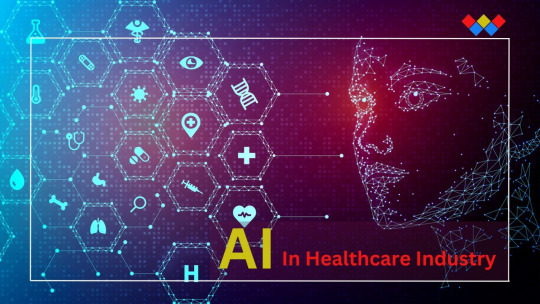
Introduction
Artificial Intelligence (AI) is revolutionizing various sectors, and healthcare is no exception. With its ability to analyze vast amounts of data, recognize patterns, and make predictions, AI holds immense potential to transform healthcare delivery, diagnosis, treatment, and patient outcomes. This article delves into the multifaceted role of AI in reshaping the landscape of healthcare.
Enhanced Diagnostics and Early Detection
One of the most significant contributions of AI in healthcare is in diagnostics and early detection of diseases. AI algorithms can analyze medical images, such as X-rays, MRIs, and CT scans, with remarkable accuracy and speed. For instance, deep learning algorithms have demonstrated capabilities comparable to or even surpassing human experts in detecting various conditions, including cancerous tumors and fractures. Moreover, AI-powered diagnostic tools can detect subtle anomalies that might escape human observation, enabling early intervention and improving patient outcomes.
Personalized Treatment Plans
AI facilitates the development of personalized treatment plans tailored to individual patients based on their unique characteristics, medical history, and genetic makeup. By analyzing vast datasets of patient records, clinical trials, and genomic information, AI algorithms can identify optimal treatment strategies with higher efficacy and fewer adverse effects. This approach, known as precision medicine, holds promise for improving treatment outcomes, minimizing healthcare costs, and reducing the burden of trial and error in drug prescriptions.
Predictive Analytics and Preventive Healthcare
Another crucial aspect of AI in healthcare is its ability to leverage predictive analytics for preventive care. By analyzing patient data and risk factors, AI algorithms can predict the likelihood of developing certain diseases or complications. This enables healthcare providers to intervene proactively, implementing preventive measures and lifestyle modifications to mitigate risks and improve patient health outcomes. Moreover, AI-powered predictive models can help identify high-risk individuals for targeted screening programs, leading to early detection and intervention, thereby reducing healthcare costs and improving population health.
Streamlined Administrative Processes
AI technologies are also streamlining administrative processes within healthcare organizations, reducing administrative burden, and enhancing operational efficiency. Natural Language Processing (NLP) algorithms, for instance, can automate medical coding, transcription, and documentation tasks, saving time for healthcare professionals and reducing errors. Additionally, AI-powered chatbots and virtual assistants are being employed for patient engagement, appointment scheduling, and providing basic medical advice, thereby improving access to healthcare services and enhancing patient satisfaction.
Drug Discovery and Development
AI is revolutionizing the drug discovery and development process, accelerating the identification of potential drug candidates and optimizing clinical trials. Machine learning algorithms can analyze large datasets of molecular structures, biological pathways, and clinical trial data to identify novel drug targets and predict the efficacy and safety of drug candidates. This enables pharmaceutical companies to expedite the drug development process, reduce costs, and bring new therapies to market more efficiently. Furthermore, AI-driven simulations and modeling techniques are facilitating the design of more precise and targeted therapeutics, leading to improved treatment outcomes and personalized medicine approaches.
Remote Patient Monitoring and Telemedicine
The proliferation of AI-powered wearable devices and remote monitoring technologies is transforming the delivery of healthcare services, particularly in remote or underserved areas. These devices can continuously collect and analyze patient data, such as vital signs, activity levels, and medication adherence, providing healthcare providers with real-time insights into patients' health status. Moreover, AI algorithms can detect deviations from normal patterns and alert healthcare providers to potential health risks, enabling timely interventions and preventing complications. Telemedicine platforms, supported by AI-driven diagnostic tools and virtual consultations, are also expanding access to healthcare services, enabling patients to receive medical advice and treatment remotely, thereby improving patient convenience and reducing healthcare disparities.
Ethical and Regulatory Considerations
While AI holds immense promise for transforming healthcare, it also raises ethical and regulatory challenges that need to be addressed. Issues such as data privacy, security, bias in algorithms, and the potential for job displacement require careful consideration and regulatory oversight. Moreover, there are concerns about the accountability and transparency of AI systems in healthcare, particularly regarding decision-making processes and patient safety. As AI technologies continue to evolve and become more integrated into healthcare systems, it is essential to establish robust ethical guidelines, regulatory frameworks, and standards to ensure responsible and equitable deployment.
Artificial Intelligence is revolutionizing healthcare delivery, diagnosis, treatment, and patient outcomes in myriad ways. From enhanced diagnostics and personalized treatment plans to predictive analytics and preventive healthcare, AI is reshaping the healthcare landscape, improving access to services, and driving innovation. However, realizing the full potential of AI in healthcare requires addressing ethical, regulatory, and implementation challenges, while ensuring patient safety, privacy, and equity. With continued research, collaboration, and investment, AI has the power to transform healthcare and usher in a new era of precision medicine and patient-centered care.
Read More: https://webrankmedia.wordpress.com/2024/04/12/the-role-of-artificial-intelligence-in-shaping-the-future-of-healthcare/
Follow Us: LinkedIn | Medium | Twitter
#AIinHealthcare#HealthcareInnovation#MedicalAI#ArtificialIntelligence#HealthTech#AIforHealthcare#MedTech#MachineLearningInMedicine#AIforMedicalResearch
0 notes
Text
Electric Vehicle (EV) Technology: The Top 10 Innovations Reshaping the Future of Transportation
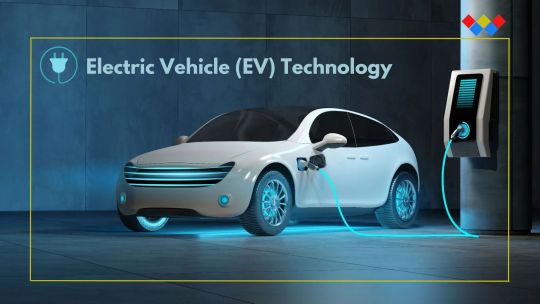
In the rapidly evolving landscape of transportation, electric vehicles (EVs) have emerged as the forefront contenders in reshaping the future of mobility. With advancements in technology, EVs are becoming more efficient, affordable, and practical for mass adoption. This article explores the top 10 innovations propelling the EV industry forward and revolutionizing transportation as we know it.
Lithium-ion Batteries:
At the heart of every electric vehicle lies its battery pack, and the development of lithium-ion batteries has been a game-changer. These batteries offer higher energy density, longer lifespan, and faster charging capabilities compared to traditional lead-acid batteries. Continuous research and development in battery chemistry are driving down costs and increasing energy storage capacity, making EVs more accessible to consumers.
2. Fast Charging Infrastructure:
One of the primary concerns for EV drivers is range anxiety, the fear of running out of battery power before reaching their destination. Fast-charging infrastructure addresses this issue by enabling rapid recharging at convenient locations. Innovations in fast-charging technology have significantly reduced charging times, with some systems capable of delivering 80% charge in as little as 30 minutes. The expansion of charging networks worldwide is crucial for widespread EV adoption.
3. Solid-State Batteries:
Solid-state batteries represent the next frontier in EV technology, offering even greater energy density, enhanced safety, and faster charging rates compared to traditional lithium-ion batteries. By replacing the liquid electrolyte with a solid material, these batteries eliminate the risk of leakage and thermal runaway, making them ideal for automotive applications. Although still in the early stages of development, solid-state batteries hold immense promise for the future of electric transportation.
4. Regenerative Braking Systems:
Regenerative braking systems capture kinetic energy during deceleration and convert it into electrical energy to recharge the battery. This technology not only improves overall efficiency but also extends the driving range of electric vehicles. By harnessing energy that would otherwise be lost as heat during braking, regenerative braking systems help maximize the energy efficiency of EVs and reduce reliance on external charging.
5. Lightweight Materials:
Reducing the weight of vehicles is critical for improving energy efficiency and increasing range. Innovations in lightweight materials, such as carbon fiber composites and aluminum alloys, are making EVs lighter without compromising structural integrity or safety. Lighter vehicles require less energy to propel, resulting in improved efficiency and performance. As these materials become more cost-effective, they will play a significant role in the mass production of electric vehicles.
6. Advanced Motors and Drivetrains:
Electric motors are at the heart of EV propulsion systems, and advancements in motor technology are enhancing performance and efficiency. Permanent magnet motors, synchronous reluctance motors, and induction motors are among the types commonly used in electric vehicles, each offering unique benefits in terms of power output, torque, and energy efficiency. Coupled with advanced drivetrains and power electronics, these motors are driving the transition towards electric mobility.
7. Vehicle-to-Grid (V2G) Integration:
Vehicle-to-grid integration enables bidirectional communication between electric vehicles and the power grid, allowing EVs to serve as energy storage devices and feed surplus electricity back into the grid during peak demand periods. This technology not only helps balance grid loads and stabilize the electrical grid but also provides EV owners with additional revenue streams through energy arbitrage. V2G integration is poised to revolutionize the way we manage energy and transportation infrastructure.
8. Autonomous Driving Capabilities:
The integration of autonomous driving technology with electric vehicles promises to revolutionize the future of transportation. Electric autonomous vehicles (EAVs) offer greater energy efficiency, reduced operating costs, and improved safety compared to traditional gasoline-powered vehicles. By leveraging artificial intelligence and sensor technology, EAVs can optimize route planning, reduce traffic congestion, and enhance overall mobility for passengers and goods.
9. Vehicle-to-Vehicle (V2V) Communication:
Vehicle-to-vehicle communication enables real-time data exchange between neighboring vehicles, allowing them to share information about road conditions, traffic patterns, and potential hazards. This technology enhances safety, improves traffic flow, and reduces the likelihood of accidents by providing drivers with advanced warning and situational awareness. V2V communication is a crucial component of future transportation systems, particularly in the context of electric and autonomous vehicles.
10. Sustainable Manufacturing Practices:
The shift towards electric vehicles is not only reshaping transportation but also driving demand for sustainable manufacturing practices. From sourcing raw materials to reducing carbon emissions during production, automakers are embracing eco-friendly initiatives to minimize their environmental footprint. Recycling programs for lithium-ion batteries, renewable energy-powered factories, and supply chain transparency are just a few examples of how the EV industry is prioritizing sustainability.
Electric vehicle technology is undergoing rapid evolution, fueled by innovation and driven by the need for sustainable transportation solutions. From advancements in battery technology to the integration of autonomous driving systems, the future of mobility is electrified. By harnessing the power of innovation, collaboration, and sustainability, electric vehicles are poised to reshape the way we move and usher in a new era of clean, efficient transportation.
Read More: https://webrankmedia.wordpress.com/2024/04/08/electric-vehicle-ev-technology-top-10-innovations-revolutionizing-the-automotive-industry/
Follow Us: LinkedIn | Medium | Twitter | Tumblr
0 notes
Photo

(Internet of Things (IoT) Empowering Smart Cities for Enhanced Connectivity and Efficiency)
🌆 Embracing the Future: Internet of Things (IoT) Empowering Smart Cities 🌐
In the heart of bustling urban landscapes, a silent revolution is underway, weaving together technology and infrastructure to create smarter, more connected communities. Welcome to the era of Smart Cities, where the Internet of Things (IoT) is the driving force behind enhanced connectivity and efficiency. 🏙️💡
Picture this: streetlights that adjust their brightness based on real-time data, optimizing energy consumption while ensuring safety; waste management systems that alert authorities when bins are full, leading to more efficient collection routes; and traffic signals that dynamically adapt to traffic flow, reducing congestion and emissions. These are just a few examples of how IoT is reshaping urban living.
At the heart of this transformation is connectivity. IoT devices, sensors, and networks form a web of communication, collecting and sharing data to enable informed decision-making. From transportation and energy management to public safety and healthcare, the possibilities are limitless.
But it's not just about collecting data – it's about what we do with it. Smart Cities leverage IoT to analyze vast amounts of information in real-time, enabling city planners to identify trends, anticipate needs, and implement proactive solutions. Whether it's optimizing public transportation routes, improving air quality, or enhancing emergency response times, IoT empowers cities to become more responsive and resilient.
Yet, with great power comes great responsibility. As we embrace the benefits of IoT, it's crucial to prioritize privacy, security, and inclusivity. Ensuring data protection and accessibility for all residents is essential to building trust and fostering widespread adoption.
As we look to the future, the potential of IoT in Smart Cities is boundless. By harnessing the power of technology to create more connected, efficient, and sustainable urban environments, we're not just building cities – we're shaping the way we live, work, and thrive together.
0 notes
Photo
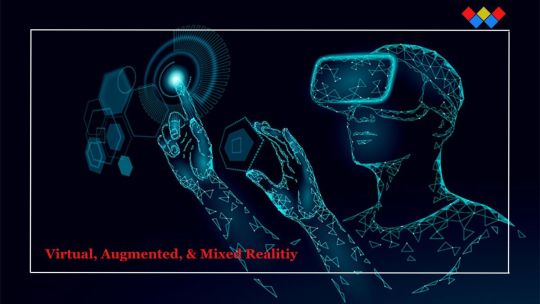
(Virtual Reality, Augmented Reality, and Mixed Reality: Shaping the Next Era of Innovation)
🌟 Dive into the Future: Virtual Reality, Augmented Reality, and Mixed Reality 🚀
Innovation knows no bounds, and with the rise of Virtual Reality (VR), Augmented Reality (AR), and Mixed Reality (MR), we're embarking on a journey into uncharted digital realms. 🌌✨
Virtual Reality 💫
Step into a world where imagination meets technology. VR transports us to entirely new dimensions, offering immersive experiences that blur the lines between the real and the digital. From exploring far-off galaxies to traversing ancient civilizations, the possibilities are as vast as the cosmos itself. Strap on your headset and prepare to embark on adventures beyond your wildest dreams! 🚀🔮
Augmented Reality 🌈
AR bridges the gap between the physical and the virtual, overlaying digital content onto our real-world surroundings. Whether it's enhancing our gaming experiences or revolutionizing how we shop, AR enriches our everyday lives in ways we never thought possible. Imagine seeing virtual creatures roaming the streets or visualizing furniture in your home before making a purchase. With AR, the boundaries of reality are pushed to new and exciting limits. 🎮👓
Mixed Reality 🌐
MR takes immersion to the next level by seamlessly blending the digital and physical worlds. It's a dynamic fusion where virtual objects interact with our real environment, creating environments where fantasy and reality coexist harmoniously. From interactive educational experiences to innovative workplace solutions, MR unlocks a realm of possibilities that redefine how we interact with our surroundings. 🏞️💡
As we stand on the cusp of this technological revolution, the potential for innovation is limitless. VR, AR, and MR are not just technologies; they're gateways to new realities, where creativity knows no bounds. So let's embrace the future and embark on a journey into the unknown, where the lines between imagination and reality blur into one breathtaking adventure. 🌟💻
0 notes
Photo
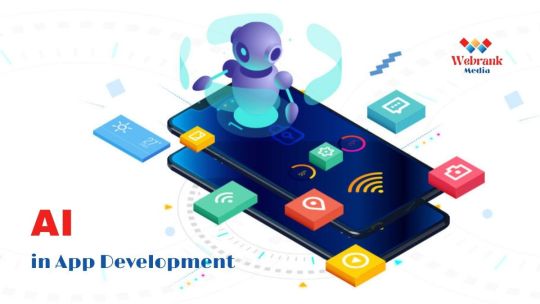
(Next-Gen Innovation: Exploring the Future of AI in App Development)
Hey Tumblr fam! Let’s delve into the fascinating world of next-gen innovation – specifically, how artificial intelligence is revolutionizing the landscape of app development. 🚀✨
As technology evolves at an exponential rate, AI has emerged as a game-changer in the realm of app development. Gone are the days of static, one-size-fits-all applications. With AI, developers now have the power to create dynamic, personalized experiences that adapt to users' preferences and behaviors.
So, what exactly does the future hold for AI in app development?
1. Enhanced User Experience: Imagine apps that intuitively anticipate your needs and preferences. AI enables developers to create highly personalized experiences by analyzing user data in real-time. From suggesting relevant content to providing tailored recommendations, AI-powered apps are revolutionizing the way we interact with technology.
2. Smarter Automation: AI isn’t just making apps smarter; it’s making them more efficient too. Through machine learning algorithms, apps can automate repetitive tasks, streamline processes, and even detect patterns that humans might overlook. This not only saves time and resources but also enhances overall productivity.
3. Advanced Analytics: Data is the lifeblood of app development, and AI is taking analytics to the next level. By harnessing the power of AI-driven analytics, developers can gain deeper insights into user behavior, identify trends, and make data-driven decisions to optimize their apps for better performance and engagement.
4. Natural Language Processing: Voice-enabled assistants like Siri and Alexa are just the tip of the iceberg. With advancements in natural language processing (NLP), AI-powered apps can now understand and respond to human speech more accurately than ever before. This opens up a world of possibilities for voice-controlled interfaces and hands-free interactions.
5. Predictive Capabilities: AI doesn’t just react to user input; it can also predict future actions based on historical data. By analyzing user behavior patterns, AI-powered apps can anticipate what users might need or want next, providing proactive recommendations and personalized experiences that feel almost magical.
As we look to the future, the potential of AI in app development is truly limitless. From revolutionizing user experiences to enhancing automation and analytics, AI is poised to redefine the way we interact with technology on a fundamental level.
So, whether you’re a developer, a tech enthusiast, or just someone who loves staying ahead of the curve, keep an eye on AI – because the future of app development is here, and it’s incredibly exciting! 🌟✨
0 notes
Photo

(Exploring the Top 10 Renewable Energy Trends in 2024: Innovations and Insights)
Powering Up: Exploring 2024's Renewable Energy Trends
Hey fellow Earth advocates! 🌍✨ Let's dive into the future of sustainable energy! As we journey further into 2024, the renewable energy landscape is evolving at warp speed, bringing with it some seriously exciting innovations. Here are the top 10 trends lighting up the renewable energy scene:
1. Solar Power Soaring: With advancements in photovoltaic technology and plummeting costs, solar energy is shining brighter than ever. From sleek solar panels integrated into buildings to massive solar farms, the sun is becoming our primary power source.
2. Wind Turbines of Tomorrow: Wind energy continues to dominate the renewable energy mix, with next-gen turbines harnessing stronger winds, reaching higher altitudes, and featuring innovative blade designs for maximum efficiency.
3. Hydrogen Hype: Hydrogen is emerging as a game-changer, offering clean energy storage solutions and powering everything from fuel cells to heavy-duty vehicles. Get ready for a hydrogen revolution!
4. Battery Breakthroughs: Breakthroughs in battery technology are unlocking the potential of renewable energy storage, paving the way for grid-scale storage systems and affordable electric vehicles with longer ranges.
5. Ocean Energy Exploration: From tidal power to wave energy converters, the vast potential of our oceans is being tapped to generate renewable electricity, providing a constant and reliable energy source.
6. Geothermal Genius: Geothermal energy is heating up as a reliable and sustainable power source, with innovative drilling techniques and advanced power plant designs making use of Earth's natural heat.
7. Biogas Boom: Turning organic waste into renewable energy through anaerobic digestion is gaining momentum, offering a green solution to waste management while producing clean biogas for electricity and heat.
8. Smart Grid Solutions: The integration of renewable energy into smart grids is revolutionizing the way we manage and distribute electricity, optimizing efficiency and resilience while empowering consumers.
9. AI for Energy Optimization: Artificial intelligence is being leveraged to optimize renewable energy systems, predicting energy demand, optimizing production, and maximizing efficiency like never before.
10. Community Power Initiatives: Community-led renewable energy projects are empowering local communities to take control of their energy future, fostering sustainability, resilience, and economic empowerment.
Let's harness the power of these innovations to create a cleaner, greener future for generations to come! Together, we can light up the world with renewable energy and pave the way to a brighter tomorrow. 💡✨
0 notes
Photo
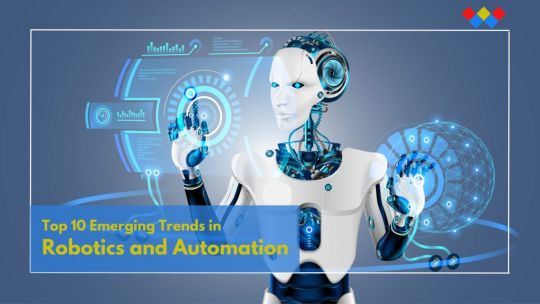
(Exploring the Top 10 Emerging Trends in Robotics and Automation)
🤖✨ Unlocking the Future: Discover the Top 10 Emerging Trends in Robotics and Automation shaping industries worldwide ✨🤖
Buckle up, fellow tech enthusiasts! 🚀 The future is knocking, and it's dressed in circuits and algorithms. Let's dive into the exciting world of robotics and automation, where innovation knows no bounds! Here are the top 10 emerging trends that are revolutionizing industries across the globe:
1. Collaborative Robots (Cobots): Say hello to your new work buddies! Cobots are designed to work alongside humans, boosting efficiency and safety in manufacturing and beyond.
2. AI-Powered Automation: Artificial Intelligence isn't just a buzzword; it's the brains behind the operation. From predictive maintenance to autonomous decision-making, AI is transforming how robots interact with the world.
3. Internet of Things (IoT) Integration: Everything's connected! IoT allows robots to communicate with each other and with other devices, creating seamless, efficient workflows.
4. 3D Printing Revolution: Imagine printing your own robot parts on demand! 3D printing is democratizing manufacturing and enabling rapid prototyping like never before.
5. Exoskeletons and Wearable Robotics: Superhuman strength, anyone? Exoskeletons are enhancing human abilities in industries like healthcare, construction, and logistics.
6. Autonomous Vehicles: From self-driving cars to drones, autonomous vehicles are reshaping transportation and logistics, making deliveries faster, safer, and more efficient.
7. Robotics in Healthcare: Robots aren't just for assembly lines anymore. From surgical assistants to caregiving companions, robotics is revolutionizing healthcare delivery.
8. Agile Manufacturing: Flexibility is the name of the game! Agile manufacturing systems are enabling rapid adaptation to changing market demands, keeping industries competitive in a fast-paced world.
9. Sustainability in Robotics: Green is the new black! Sustainable practices, from energy-efficient designs to recyclable materials, are shaping the future of robotics and automation.
10. Human-Robot Interaction: It's all about harmony! Designing robots that understand and respond to human behavior is key to creating a future where man and machine coexist peacefully.
So there you have it, folks! The future of robotics and automation is bright, bold, and brimming with possibilities. Whether you're a tech aficionado or simply curious about what lies ahead, one thing's for sure: the age of robots is upon us, and it's going to be one heck of a ride! 🤖✨
1 note
·
View note